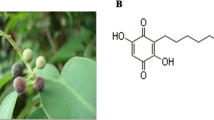Abstract
Photodynamic therapy (PDT) is a technique for inducing tissue damage with light irradiation of a drug selectively retained in malignant tissue. Many kinds of compounds are known with photosensitizing properties including dyes, drugs, cosmetics, chemicals, and many natural substances. There are different classes of sensitizers used for medical purposes such as tetrapyrroles (porphyrins and derivatives, chlorophyll, phylloerythrin, phthalocyanines), tricyclic dyes with different meso-atoms (acridine orange, proflavine, riboflavine, methylene blue, fluorescein, eosine, erythrosine, rose bengal), and furocoumarins (psoralen and its methoxyderivatives xanthotoxin, bergaptene). In this work, we performed one comparative cytotoxic study of the photodynamic activity presented by tricyclic dyes (methylene blue, fluorescein and erythrosine) and the commercial Russian photosensitizer Photogem® (hematoporphyrin derivative). For this purpose, three cell lines were used: HEp-2 (tumor cells), VERO and McCoy (nontumor cells), and a yeast strain. The wavelength used for irradiation was 630 nm, the same as used in PDT for medical purposes, since it is in the therapeutic window, i.e., where light can penetrate more into the tissues. The results suggest that Photogem® is more cytotoxic and more photocytotoxic than the studied tricyclic dyes in nontumor and tumor cells. These dyes present less cytotoxicity (around half) in normal cells (dark and light) than in tumor cells. In the experiments with microorganisms, methylene blue presented a better photodynamic effect than Photogem®. These results can be explained by the fact that it is more difficult for Photogem® to penetrate in microorganism membranes than mammalian cell membranes. As for Photogem®, these tricycle dyes present a higher cytotoxicity in tumor cells. These data suggest that methylene blue can be an option in photodynamic inactivation as well as in photodynamic therapy, mainly for superficial lesions.
Similar content being viewed by others
References
M. R. Hamblin and T. Hasan, “Photodynamic Therapy: A New Antimicrobial Approach to Infectious Disease?,” Photochem. Photobiol. Sci. 3, 436 (2004).
K. Orth et al., “Methylene Blue Mediated Photodynamic Therapy in Experimental Colorectal Tumors in Mice,” J. Photochem. Photobiol., B 57(2–3), 186 (2000).
S. B. Brown, E. A. Brown, and I. Walker, “The Present and Future Role of Photodynamic Therapy in Cancer Treatment,” Lancet. Oncol. 5(8), 497 (2004).
J. P. Tardivo, A. D. Giglio, C. S. Oliveira, et al., “New Photodynamic Therapy Protocol to Treat AIDS-Related Kaposi’s Sarcoma,” Photodiagnosis Photodyn. Therapy 2, 175 (2005).
C. H. Sibata, V. C. Colussi, N. O. Oleinick, and T. J. Kinsella, “Photodynamic Therapy in Oncology,” Expert Opin. Pharmacother. 2, 917 (2001).
M. G. Strakhovskaya et al., “Fungicidal Activity of Khlorin Photosensitizers,” Dokl. Biochem. Biophys. 384, 155 (2002).
M. G. Strakhovskaya et al., “The Photodynamic Inactivation of the Yeast Candida Quilliermondii in the Presence of Photodithazine,” Microbiology 71(3), 298 (2002).
P. Meisel and T. Kocher, “Photodynamic Therapy for Periodontal Diseases: State of the Art,” J. Photochem. Photobiol., B. 79(2), 159 (2005).
M. Wainwright, “The Use of Dyes in Modern Biomedicine,” Biotech. Histochem. 78(3–4), 147 (2003).
F. Denizot and R. Lang, “Rapid Nolorimetric Assay for Cell Growth and Survival. Modifications to the Tetrazolium Dye Procedure Giving Improved Sensitivity and Reliability,” J. Immunol. Methods 89(2), 271 (1986).
J. Cannichael et al., “Evaluation of a Tetrazolium-Based Semiautomated Colorimetnc Assay: Assessment of Chemosensitivity Testing,” Cancer Res. 47, 936 (1987).
T. H. M. Chou, Calcusyn: Windows Software for Dose Effect Analysis (BIOSOFT, Cambridge, 1996).
Author information
Authors and Affiliations
Additional information
Original Text © Astro, Ltd., 2007.




